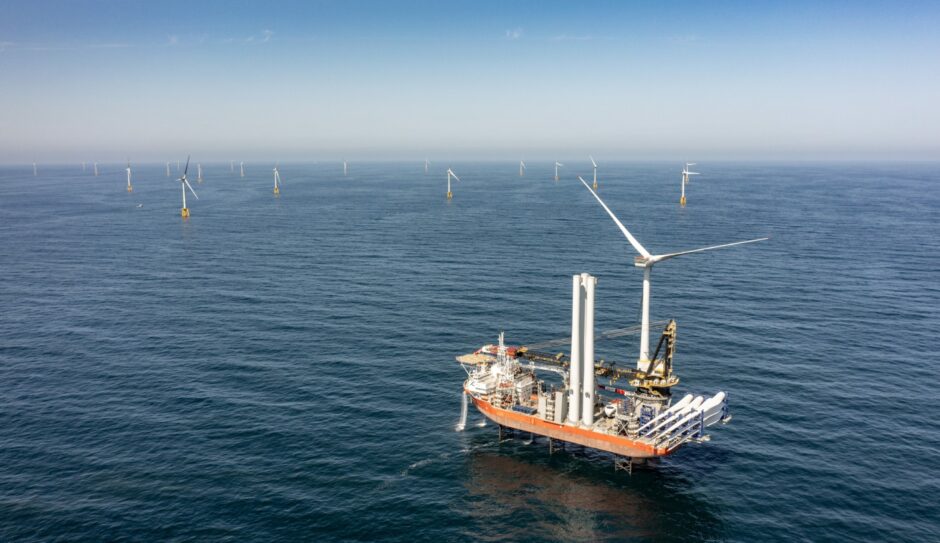
The saying “may you live in interesting times” – often erroneously thought of as a Chinese curse – can easily be attributed to the wind sector during 2023.
In Scotland, we opened 2023 one year on from the heady days of the ScotWind announcement, and closed the year recently celebrating the Seagreen Offshore Wind Farm becoming fully operational. A milestone project that is the world’s deepest fixed bottom project and generates enough capacity to power the equivalent of two-thirds of all Scottish homes.
However, as 2023 came out of the blocks, we can now look back at clear signals of troubles ahead. In March Orsted fired a warning shot across the UK Govt’s bow regarding the viability of its Hornsea 3 project citing supply chain pressures and rising interest rates.
Those of us in the sector started seeing examples of cost increases of up to 40% in projects. Like a slowly boiling frog suddenly waking up to the fact, the sector suddenly and dramatically reacted.
We saw projects getting cancelled, delayed and/or termination and attempts to re-negotiation of PPAs in the US; Park City Wind, Empire Wind 1&2, Commonwealth Wind, Beacon Wind 1&2, and Sunrise all hit the skids in some form.
In the UK the trouble started with Vattenfall cancelling its Norfolk Boreas project, a project with an AR4 CfD. But at £37.35/MWh, a marginal price that became impossible as costs exploded. What followed in the UK was a ringing message to the Govt from developers, they took a unanimous pass at AR5 and it’s £44/MWh strike price.
If the year had finished in October, it would have been worthy of the doomy mainstream media headlines of those weeks.
But while the main cause of the cost inflation spike was the Russian invasion of Ukraine, it was a spike on a trend with an already upward trajectory. Finance costs were rising already and raw materials costs had started to rise after COVID. The supply chain’s profitability, and so ability to grow its supply side to meet demand was suffering the death of a thousand cuts.
Victims of success
In a major sense this was all due to the runaway success of our sector. Brave new markets with huge potential like the US opened up to European developers who had offshore wind ‘sussed’, and allowed latecomers with deep hydrocarbon enriched pockets a new market with scale potential to enter on an equal footing with more experienced players.
The UK Govt, drunk with driving down offshore wind from c£114-120/MWh in 2015 to £37.35 in AR4, did not see the pain and problems ahead.
The demand for seabed outstripped demand, the result was high bid prices adding costs to projects, but also capped offtake auctions resulted in uber competitive bidding for PPAs and CfDs. Hindsight is 20/20, but a lot of what we have seen carry the typical symptoms of an asset bubble; low interest rates stimulating borrowing, increasing favourable conditions driving an influx of interest, a high demand matched with a shortage of supply. The steep raw material inflation compounded by supply chain shortages and grid/consenting delays caused fundamental changes to the intrinsic worth of the projects.
This does not mean that it is all the developers fault, all in the industry are complicit, but nobody put a gun to heads to the developers in question. They just got burnt.
But the year did not end in October.
With candid engagement from developers following the clear message sent in AR5, industry and from across govt departments, the UK govt announced the AR6 strike prices.
They announced a maximum strike price for fixed bottom wind as £73/MWh and £176/MWh for floating. This was ahead of my estimation of circa £65/MWh and 150/MWh, but includes a risk element for TNUoS charges, it is hoped we will see 10GW of capacity get awarded in the summer.
This announcement together with across the Atlantic, New York in particular, coming back to the market quickly with new offtake solicitations, 4GW awarded announced late in Oct and an additional due in January 2024 may revive some of the troubled projects, all signalled an appetite to recalibrate to the real world pressures impacting the sector.
With the UK making other advantageous announcements/conditions late in the year including a Green Industries Growth Accelerator with £1bn of funding, the joint Connections Action Plan (CAP) attempting to halve the time it takes renewables to connect to the grid, a Round 5 Floating Round, a signal to exempt renewable energy investments from the perverse windfall tax on renewables, and other financial incentives.
And in mid-December, Orsted capped off its year by announcing a successful FID for Hornsea 3.
All help to create a different investment environment, both on the ground but also in terms of confidence, and of course the global pipeline continues to increase. We will see around 50GW of new capacity being awarded in Europe alone.
The issues we face are by no means over, but we have reasons to be more confident looking at 2024 than we did 3 or so months ago.
Offshore wind will show itself to be the ‘comeback kid’ in 2024, though there are still challenges to be met and worked through, I am sure we eventually look back on 2023 as one of growing pains and nothing more.
Recommended for you

 © Supplied by Offshore Wind Consul
© Supplied by Offshore Wind Consul